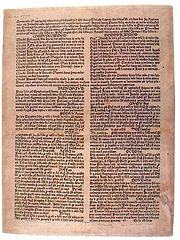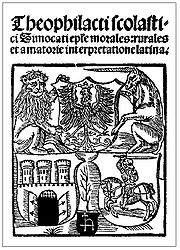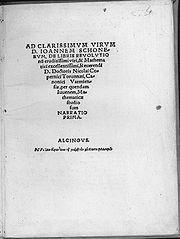
History of printing in Poland
Encyclopedia



Gutenberg Bible
The Gutenberg Bible was the first major book printed with a movable type printing press, and marked the start of the "Gutenberg Revolution" and the age of the printed book. Widely praised for its high aesthetic and artistic qualities, the book has an iconic status...
in 1455, printers from Western Europe spread the new craft abroad.
The Polish capital at the time was in Kraków
Kraków
Kraków also Krakow, or Cracow , is the second largest and one of the oldest cities in Poland. Situated on the Vistula River in the Lesser Poland region, the city dates back to the 7th century. Kraków has traditionally been one of the leading centres of Polish academic, cultural, and artistic life...
, where scholars, artists and merchants from Western Europe had already been present. Other cities which were part of the Polish kingdom
Kingdom of Poland (1385–1569)
The Kingdom of Poland of the Jagiellons was the Polish state created by the accession of Jogaila , Grand Duke of Lithuania, to the Polish throne in 1386. The Union of Krewo or Krėva Act, united Poland and Lithuania under the rule of a single monarch...
followed later. Cities of northern Polish province of Royal Prussia
Royal Prussia
Royal Prussia was a Region of the Kingdom of Poland and of the Polish-Lithuanian Commonwealth . Polish Prussia included Pomerelia, Chełmno Land , Malbork Voivodeship , Gdańsk , Toruń , and Elbląg . It is distinguished from Ducal Prussia...
., like the Hanseatic League
Hanseatic League
The Hanseatic League was an economic alliance of trading cities and their merchant guilds that dominated trade along the coast of Northern Europe...
city of Danzig (Gdańsk), had established printing houses early on.
The first printing shop was possibly opened in Kraków by Augsburg
Augsburg
Augsburg is a city in the south-west of Bavaria, Germany. It is a university town and home of the Regierungsbezirk Schwaben and the Bezirk Schwaben. Augsburg is an urban district and home to the institutions of the Landkreis Augsburg. It is, as of 2008, the third-largest city in Bavaria with a...
-based Günther Zainer
Günther Zainer
Günther Zainer was the first printer in Augsburg, where he worked from 1468 until his death; he produced about 80 books including two German editions of the Bible and the first printed calendar. He came to Augsburg from Strassburg and printed in 1472–76 three large works of moral instruction...
in 1465. In 1491, Schweipolt Fiol
Schweipolt Fiol
Schweipolt Fiol from Neustadt an der Aisch in Franconia was a German-born 15th century pioneer of printing in Eastern Europe....
printed the first book in Cyrillic script.
The next recorded printing shop was a Dutch one known by the name Typographus Sermonum Papae Leonis I. that might have been established in 1473 on Polish territory, but its exact location has yet to be determined.
The oldest known print from Poland is considered to be the Almanach cracoviense ad annum 1474
Almanach Cracoviense ad annum 1474
Almanach cracoviense ad annum 1474 is a single-sheet astronomical wall calendar for the year 1474, and Poland's oldest known print...
(Cracovian Almanac for the Year 1474) which is a single-sheet astronomical wall calendar
Wall calendar
A wall calendar is a calendar intended for placement on a wall. Wall calendars can serve as reminders of holidays, important events, and company events. They typically consist of a collection of images on a given subject....
for the year 1474 printed and published in 1473 by Kasper Straube
Kasper Straube
Kasper Straube was a German 15th century printer from Bavaria.He was active in Cracow between 1473 and 1477, decades before Johann Haller...
. The only surviving copy of Almanach cracoviense measures 37 cm by 26.2 cm, and is in the collections of the Jagiellonian University
Jagiellonian University
The Jagiellonian University was established in 1364 by Casimir III the Great in Kazimierz . It is the oldest university in Poland, the second oldest university in Central Europe and one of the oldest universities in the world....
.
The first print written in Polish language
Polish language
Polish is a language of the Lechitic subgroup of West Slavic languages, used throughout Poland and by Polish minorities in other countries...
is believed to be Hortulus Animae polonice, a Polish version of Hortulus Animae written by Biernat of Lublin
Biernat of Lublin
Biernat of Lublin was a Polish poet, fabulist, translator and physician. He was one of the first Polish-language writers known by name, and the most interesting of the earliest ones...
, printed and published in 1513 by Florian Ungler
Florian Ungler
Florian Ungler and Kasper Hochfeld were printers from Bavaria that after 1510 became pioneers of printing and publishing in Polish language.*1512 Introductio in Ptolomei Cosmographiam, with maps of America...
in Kraków. The last known copy was lost during World War II
World War II
World War II, or the Second World War , was a global conflict lasting from 1939 to 1945, involving most of the world's nations—including all of the great powers—eventually forming two opposing military alliances: the Allies and the Axis...
.
One of the first commercial printers in Poland
Poland
Poland , officially the Republic of Poland , is a country in Central Europe bordered by Germany to the west; the Czech Republic and Slovakia to the south; Ukraine, Belarus and Lithuania to the east; and the Baltic Sea and Kaliningrad Oblast, a Russian exclave, to the north...
is considered to be Johann Haller
Johann Haller
Johann Haller or Jan Haller is considered one of the first commercial printers in Poland.-Copernicus:Born in Rothenburg, Haller is perhaps best known for publishing in 1509 a volume of poems by Theophylact Simocatta which had been translated from Byzantine Greek by Nicolaus Copernicus...
who worked in Kraków in the early 16th century (since 1505) who in 1509 printed Nicolaus Copernicus
Nicolaus Copernicus
Nicolaus Copernicus was a Renaissance astronomer and the first person to formulate a comprehensive heliocentric cosmology which displaced the Earth from the center of the universe....
Theophilacti Scolastici Simocatti Epistole morales, rurales at amatoriae, interpretatione latina.
Other well known early printers in Poland are:
- Hieronymus Vietor from SilesiaSilesiaSilesia is a historical region of Central Europe located mostly in Poland, with smaller parts also in the Czech Republic, and Germany.Silesia is rich in mineral and natural resources, and includes several important industrial areas. Silesia's largest city and historical capital is Wrocław...
who worked in ViennaViennaVienna is the capital and largest city of the Republic of Austria and one of the nine states of Austria. Vienna is Austria's primary city, with a population of about 1.723 million , and is by far the largest city in Austria, as well as its cultural, economic, and political centre...
and Kraków - Printers from the Szafenberg family,
- Florian UnglerFlorian UnglerFlorian Ungler and Kasper Hochfeld were printers from Bavaria that after 1510 became pioneers of printing and publishing in Polish language.*1512 Introductio in Ptolomei Cosmographiam, with maps of America...
In the late 16th century there were 7 printing shops in Kraków, and in 1610 10 printing shops. A decline started in around 1615. Due to this fact in 1650 there remained only 3 secular printing shops, accompanied by a few ecclesial ones.
Only one printing shop is recorded in Warszawa in 1707, owned by the Piarists
Piarists
The Order of Poor Clerics Regular of the Mother of God of the Pious Schools or, in short, Piarists , is the name of the oldest Catholic educational order also known as the Scolopi, Escolapios or Poor Clerics of the Mother of God...
. This situation improved during the realm of the last Polish king, Stanisław August Poniatowski, that marked political and cultural revival in Poland. Unfortunately his attempts to reform the state led to the Partitions of Poland
Partitions of Poland
The Partitions of Poland or Partitions of the Polish–Lithuanian Commonwealth took place in the second half of the 18th century and ended the existence of the Polish–Lithuanian Commonwealth, resulting in the elimination of sovereign Poland for 123 years...
carried out by Prussia
Prussia
Prussia was a German kingdom and historic state originating out of the Duchy of Prussia and the Margraviate of Brandenburg. For centuries, the House of Hohenzollern ruled Prussia, successfully expanding its size by way of an unusually well-organized and effective army. Prussia shaped the history...
, Austria
Austria
Austria , officially the Republic of Austria , is a landlocked country of roughly 8.4 million people in Central Europe. It is bordered by the Czech Republic and Germany to the north, Slovakia and Hungary to the east, Slovenia and Italy to the south, and Switzerland and Liechtenstein to the...
and Russia
Russia
Russia or , officially known as both Russia and the Russian Federation , is a country in northern Eurasia. It is a federal semi-presidential republic, comprising 83 federal subjects...
.
See also
- Global spread of book printing
- History of printingHistory of printingThe history of printing started around 3000 BC with the duplication of images. The use of round "cylinder seals" for rolling an impress onto clay tablets goes back to early Mesopotamian civilization before 3000 BC, where they are the most common works of art to survive, and feature complex and...
- Book of HenrykówBook of HenrykówThe Book of Henryków is a Latin chronicle of the Cistercian abbey in Henryków in Lower Silesia. Originally created as a registry of belongings looted by the Mongol raids of 1241, with time it was extended to include the history of the monastery...
- Almanach cracoviense ad annum 1474Almanach Cracoviense ad annum 1474Almanach cracoviense ad annum 1474 is a single-sheet astronomical wall calendar for the year 1474, and Poland's oldest known print...
- Kasper StraubeKasper StraubeKasper Straube was a German 15th century printer from Bavaria.He was active in Cracow between 1473 and 1477, decades before Johann Haller...
- Johann HallerJohann HallerJohann Haller or Jan Haller is considered one of the first commercial printers in Poland.-Copernicus:Born in Rothenburg, Haller is perhaps best known for publishing in 1509 a volume of poems by Theophylact Simocatta which had been translated from Byzantine Greek by Nicolaus Copernicus...
- Florian UnglerFlorian UnglerFlorian Ungler and Kasper Hochfeld were printers from Bavaria that after 1510 became pioneers of printing and publishing in Polish language.*1512 Introductio in Ptolomei Cosmographiam, with maps of America...

